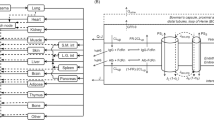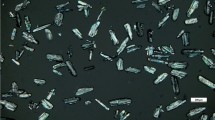Abstract
The purpose of this study was to identify optimal preservatives for a multidose formulation of a humanized monoclonal antibody using experimental design techniques. The effect of antimicrobial parenteral preservatives (benzyl alcohol, chlorobutanol, methyl paraben, propylparaben, phenol, and m-cresol) on protein stability was assessed using size-exclusion chromatography, differential scanning calorimetry, right-angle light scattering, UV spectroscopy, and potency testing using a cell-based fluorescence-activated cell sorting method. A quick, cost-effective preservative screening test was designed. Combinations of preservatives were examined using an I-optimal experimental design. The protein was most stable in the presence of methylparaben and propylparaben, and was compatible with benzyl alcohol and chlorobutanol at low concentrations. Phenol and m-cresol were not compatible with the protein. The I-optimal experimental design indicated that as an individual preservative, benzyl alcohol was promising. The model also indicated several effective combinations of preservatives that satisfied the antimicrobial efficacy and physical stability constraints. The preservative screening test and the experimental design approach were effective in identifying optimal concentrations of antimicrobial preservatives for a multidose protein formulation; (1) benzyl alcohol, and (2) the combination of methylparaben and chlorobutanol were screened as potential candidates to satisfy the regulatory requirements of various preservative efficacy tests.
Similar content being viewed by others
References
McGoff P, Scher DS. Solution formulation of proteins/peptides. In: McNally EJ, ed. Protein Formulation and Delivery. New York, NY: Marcel Dekker, 2000:139–158.
Akers MJ, Defelippis MR. Peptides and proteins as parenteral solutions. In: Frokjaer S, Hovgaard L, eds. Pharmaceutical Formulation Development of Peptides and Proteins. Philadelphia, PA: Taylor and Francis; 2000:145–177.
Bontempo JA. Formulation development. In: Bontempo JA, ed. Development of Biopharmaceutical Parenteral Dosage Forms. New York, NY: Marcel Dekker; 1997:109–142.
Lachman L, Weinstein S, Hopkins G, Slack S, Eisman P, Cooper J. Stability of antibacterial preservatives in parenteral solutions, I. Factors Influencing the Loss of Antimicrobial Agents from Solutions in Rubber-Stoppered Containers, J Pharm Sci. 1962;51(3):224–232.
Kakemi K, Sezaki H, Arakawa E, Ideda K. Interaction of parabens and other pharmaceutical adjuvants with plastic containers. J Chem Pharm Bull. 1971;19(12):2523–2529.
Akers MJ. Considerations in selecting antimicrobial preservatives for parenteral product development. Pharm Technol. 1984;8(5):36–44.
Beasley CRW, Rafferty P, Holgate ST. Bronchoconstrictor properties of preservatives in ipratropium bromide (Atrovent) nebulizer solution. Br Med J. 1987;294:1197–1198.
Maa YF, Hsu CC. Aggregation of recombinant human growth hormone induced by phenolic compounds. Int J Pharm. 1996;140:155–168.
Kim Y, Rose CA, Liu Y, Ozaki Y, Datta G, Ut AT. FT-IR and near-infrared FT-Raman studies of the secondary structure of insulinotropin in the solid state: α-helix to β-sheet conversion by phenol and/or high shear force. J Pharm Sci. 1994;83:1175–1180.
Lam XM, Patapoff TW, Nguyen TH. The effect of benzyl alcohol on recombinant human interferon-γ. Pharm Res. 1997;14:725–729.
Author information
Authors and Affiliations
Corresponding author
Additional information
Published: April 4, 2003
Rights and permissions
About this article
Cite this article
Gupta, S., Kaisheva, E. Development of a multidose formulation for a humanized monoclonal antibody using experimental design techniques. AAPS PharmSci 5, 8 (2003). https://doi.org/10.1208/ps050208
Received:
Accepted:
Published:
DOI: https://doi.org/10.1208/ps050208




